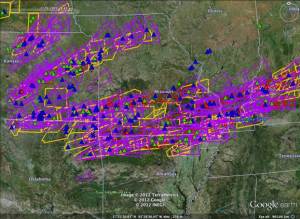By John Bosse
After more than three years in development and network deployment, we are excited to share our newest storm warning technology, called Dangerous Thunderstorm Alerts (DTAs). DTAs are issued by Earth Networks and provide advanced notification of the increased threat of severe weather moving into an identified area. DTAs supplement the alerts issued by the National Weather Service for severe thunderstorms and tornadoes. DTAs are based on our Earth Networks Total Lightning Network (ENTLN).
What is the ENTLN? It’s the world’s largest total lightning network with more than 500 sensors that detect both cloud-to-ground lightning as well in -cloud and intra-cloud pulses.
Since high rates of in-cloud lightning often indicate the potential for severe weather phenomena, our network can provide advanced warnings for heavy rain, large hail, dangerous cloud-to-ground lightning strikes and even tornadoes like the ones that ripped through wide swaths of the Midwest and Southern U.S. earlier this year.

Image shows Earth Networks Dangerous Thunderstorm Alerts (DTAs) issued during the February 28-29, 2012 severe weather event that killed 13 people from the Plains into the Tennessee Valley.
• Purple Polygons: DTAs
• Orange and Red Polygons: NWS severe thunderstorm warnings and tornado warnings
• Triangles: Local storm reports of hail, high winds, structure damage and tornadoes
We recently shared an analysis of 17 tornadic events in Alabama, Indiana, Tennessee, Kentucky, Kansas, Missouri and Illinois from February 28-March 2, 2012 in a webinar directed at emergency management personnel, government officials, first responders, and utilities.
The analysis showed that using Earth Networks’ DTAs can increase the median lead times by 15 minutes — that’s double the lead time typically available today. Additionally, the combined spatial and temporal resolution of the system offers many benefits that are complementary to traditional radar, satellite and surface observations. That translates into additional time to mobilize crews, secure assets, and seek shelter when minutes matter.
For professionals who missed the webinar, we have an excerpt available online. Use this link to access the webinar: New Storm Alerts for Emergency Managers.
Are you an emergency responder? What challenges do you face during extreme weather events? I’m interested in hearing your story. Email me at jbosse@earthnetworks.com.